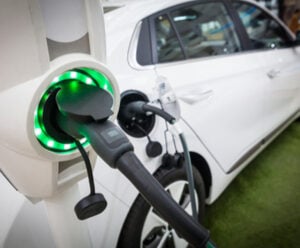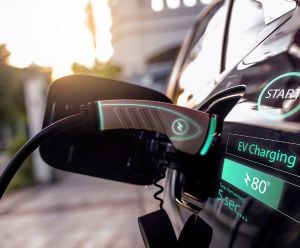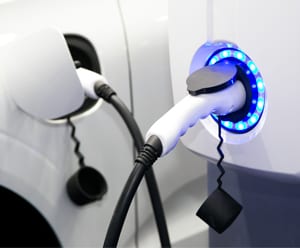
Electrifying the supply chain: A guide to exploring the batteries powering EVs

Electric vehicles (EVs) have taken the world by storm, with global sales of passenger EVs spiking from 6.5 million in 2021 to 14.1 million in 2023.
The burgeoning popularity of EVs boils down to two key reasons. Besides being a green alternative to internal combustion engine (ICE) vehicles, EVs simplify the supply chain and boost transport efficiency.
So, what is charging the EV revolution? The answer is the EVs’ batteries. Each battery accounts for at least 30 to 40 percent of an EV’s value, boasting a high power-to-weight ratio to power a standard EV for up to 100 miles (160.9 km).
EV users need to know how to prolong the longevity of their EVs. From understanding charging speeds and insurance to battery swapping and recycling, here is all you need to know about maintaining EVs and their batteries.
Charging ahead, slowly, or quickly
Like choosing between fast and slow-charging cables to recharge your smartphone, EVs have charging levels that vary depending on their make and local regulations.
Typically, EV manufacturers provide users with slow-charging portable chargers that utilize alternating currents (AC), which are used almost exclusively at home as they take at least 10 hours to complete a full charge.
As such, AC chargers are not feasible for public use. Instead, road charging stations are outfitted with fast-charging capabilities to facilitate swift battery recharges on the go. Some even offer ultra-fast charging via direct currents (DC).
Unlike AC chargers that must convert currents before supplying energy to the battery, DC chargers deliver power directly, enabling them to replenish an EV battery’s charge within an hour.
However, as DC charging can potentially degrade the battery, it is not as widely deployed as regular fast-charging options, which constitute almost 80 percent of public charging ports in the U.S.
Still, as recent studies have demonstrated that DC charging has minimal impact on battery longevity, it could become more widely adopted. The U.S., for example, has recently pumped in federal funding through schemes like the National Electric Vehicle Infrastructure Formula Program and the National Alternative Fuels Corridors grant program to increase the number of DC charging stations across the country.
To facilitate interoperability between charging point vendors and charging software providers, most EV chargers abide by the Open Charge Point Protocol (OCPP), the most widely recognized charging standard across the world.
Moreover, EV batteries must be regularly serviced, and a charge between 20 percent and 80 percent must be maintained to prolong their longevity. EVs should also not be subjected to extremely warm or cold temperature conditions.
Another point to consider is insurance. EV insurance policies often exclude battery wear-and-tear and other defects, necessitating additional battery maintenance coverage. Typically, EV insurers provide two types of premiums: per kilometer (km), or the annual plan, which is ideal for logistics as it clocks significant mileage and is more cost-efficient in the long run.
Battery swapping as a quick and easy substitute
Given how extensive battery maintenance can be, it may not always be the most feasible option for users. Alternatively, users can simply swap their spent batteries for fresh ones.
Battery swapping is performed at battery swapping stations, where users can swap their discharged battery packs for charged ones.
Although battery swapping cuts the time needed to get an EV back on the road, it has yet to be widely adopted. In 2015, Tesla pioneered a battery swapping demonstration site at its Harris Ranch supercharger station, though they eventually scrapped battery swapping due to it being unsuitable for widescale use.
The situation is different in China, the world’s largest EV market with 55 percent of global EV sales (3.4 million units) in H1 2023, a stark contrast to the U.S.’s 13 percent. The country’s burgeoning EV ownership has prompted its government to diversify its focus on charging options to include battery swapping and develop a Standard on Safety Requirements for EV Battery Swap Systems in 2021 to support battery swapping.
In line with the Chinese government’s vision to promote battery swapping and EV adoption, carmakers Nio and Geely, battery swapping developer Aulton, and state-owned oil manufacturer Sinopec have committed to building 24,000 swap stations across China by 2025. Nio and Geely even sealed a partnership in 2023, aiming to “popularize battery swapping, [and] offer high-quality and convenient experience to more users.”
The lithium-ion battery conundrum
While battery swapping is a convenient solution, it is not the most sustainable option. This is because EV lithium-ion batteries are manufactured with expensive raw materials like lithium, cobalt, nickel, and graphite. As these materials are not readily available, they inevitably trigger shortages that strain the EV battery supply chain.
For instance, while cobalt is commonly used in battery cathodes, it is a costly and limited resource. Substitutes such as lithium iron phosphate have been considered replacements, but none can deliver as much power as cobalt.
To complicate the situation, EV battery demand has begun outstripping supply, rising by at least 65 percent to 550 gigawatt-hours (GWh) in 2022, up from 330 GWh in 2021.
In turn, upward pressure has been exerted on the demand for critical battery materials. In 2022 alone, 60 percent of lithium, 30 percent of cobalt, and 10 percent of nickel global demand was used for EV batteries — a significant spike compared to 15 percent, 10 percent, and 2 percent respectively, in 2017.
The Russia-Ukraine conflict that began in 2022 further magnified the lithium-ion battery problem, causing the prices of battery materials to soar by at least 50 percent. Demand is expected to continue surging by at least 30 percent to an estimated 4,500 GWh a year globally by 2030
Although EV battery manufacturers will have the capacity to supply projected EV production until 2025, estimates by Benchmark Mineral Intelligence indicate they may face a shortfall of almost 9 percent in battery production versus EV demand by 2030.
Recycling batteries to combat shortages
To combat the global lithium shortage, EV makers have set their sights on recycling existing batteries.
Research has found that recycled EV batteries can perform better than brand-new ones. According to Yan Wang, a materials science professor at Worcester Polytechnic Institute, recycled cathode powder is more porous than new cathode powder, giving the cathode crystal more room to expand without cracking.
In Singapore, battery recycling startup NEU Battery Materials produced an innovative way to utilize electricity to recycle lithium from used lithium-ion batteries and reduce battery waste.
Although battery recycling can be a feasible solution to the EV battery problem, it is not widely adopted because lithium typically requires multiple rounds of purification — a process more expensive than simply mining more lithium. As such, only 5 percent of lithium-ion batteries were recycled globally in 2021.
Preparing Asia for the EV wave with the Batam EV Center of Excellence
Preparing Asia for the EV wave with the Batam EV Center of Excellence
DHL Global Forwarding announced the opening of its Batam EV Center of Excellence in March 2024. This first-of-its-kind facility in Indonesia offers a comprehensive range of EV services, promising tailored solutions to every customer's needs, including inbound and outbound multimodal logistics, aftermarket battery handling, and innovative warehousing solutions.
Batam was strategically chosen because of its proximity to the Asia Pacific Hub and its abundance of natural resources that are important to EV battery production. With expertise in handling EV logistics, DHL will help Indonesia achieve its goal of ranking among the world’s top three EV battery producers by 2027.
“Indonesia, with its abundant natural resources of nickel and cobalt, has a critical position in developing an integrated EV supply chain," said, Vincent Yong, President Director, DHL Global Forwarding Indonesia. "In line with the Indonesian government's goal to become one of the global EV battery producers by 2027, the establishment of the Batam EV Center of Excellence marks an important milestone to support this goal, while strengthening the local EV industry."
Decoupling batteries from EVs in the future
However, the situation is set to change given the pressure exerted on the global lithium supply. According to projections from Statista, the value of the lithium-ion battery recycling market is expected to rise from US$6.5 billion in 2022 to US$35.1 billion by 2031.
As Principal Consultant of Nodeology, Anthony Grescavage, astutely observes, EVs do not need to be locked to their batteries as electricity can be derived from various sources, whether fossil fuels, solar, or nuclear power. By decoupling batteries from EVs, the upfront cost can be significantly reduced, making them more affordable and accessible.
And as the EV market continues to grow, streamlined logistical processes will prove critical in building a complete audit trail from production to final use, enabling battery supply chains to maintain their global presence sustainably.
ALSO WORTH READING














 English
English